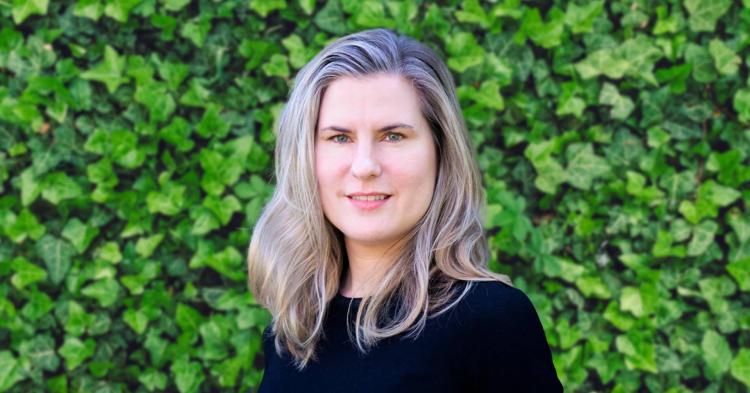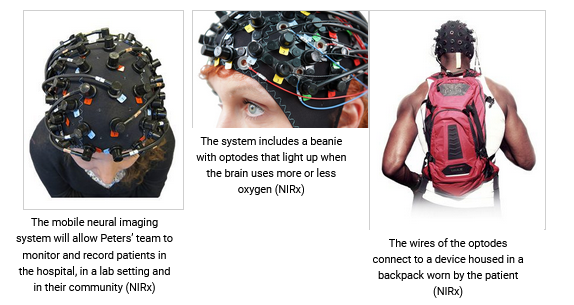
Neuroscientist and physiotherapy professor Sue Peters is one of seven Western researchers to receive infrastructure funding from the Canada Foundation for Innovation. (Submitted)
Seven Western researchers have been awarded a total of $1.6 million from the Canada Foundation for Innovation (CFI) to tackle national and global research challenges. This funding will help advance work in important areas, including health and well-being, climate change, and sustainable energy sources.
François-Philippe Champagne, Minister of Innovation, Science and Industry, announced the funding today (Sept 21) as part of a $64 million investment supporting 251 research infrastructure projects at 40 universities across Canada. The investment comes through the CFI's John R. Evans Leaders Fund (JELF), designed to help universities recruit and retain outstanding researchers by helping fund the labs, equipment and facilities essential to making discoveries that will have an impact on Canadians.
"Canada is world-renowned for state-of-the-art institutions and talented researchers," Champagne said. "Through this fund, our government is strengthening our leadership and competitive advantage by supporting Canadians to pursue discoveries, overcome challenges and innovate to make a more prosperous, equitable and sustainable future for all."
Enhancing mobility after stroke
For Sue Peters, a neuroscientist at the Western Institute for Neuroscience, physiotherapy professor in the Faculty of Health Sciences, and Gray Centre for Mobility and Activity scientist, the JELF support will allow her to purchase mobile neuroimaging equipment and a compatible electromyography system that will significantly impact her work to help improve mobility recovery in stroke survivors.
And with 50,000 Canadians experiencing a stroke each year, the potential for impact is great.
"The number one goal for the majority of stroke survivors is to regain the ability to walk in their community," Peters said. "However, damage to neural activation and gait asymmetries are highly limiting, meaning about 30 per cent of stoke survivors are unable to do so."
Peters, BA'05, MA'07 (Physical Therapy), has been curious about how the brain influences movement since studying kinesiology at Western as an undergrad. Staying on to continue her studies in the physical therapy master's program, she became exposed to neuroscience, learning about the damage stroke can do to the brain. She worked as a physiotherapist for five years before pursuing her PhD, gaining experience and a patient perspective that helps inform her work as a researcher in her Neurorehabilitation Physiology Lab at Parkwood Institute, in London, Ont.
Brain damage caused by stroke cannot be reversed. However, through a process called neuroplasticity, rehabilitation activities can help encourage new connections in the brain to compensate for the damage after the stroke.
"If we can use mobile neuroimaging to identify patterns in the brain while stroke survivors are still in-patients, we can intervene with more intensive therapy or more specialized therapies," Peters said.
Up until now, knowledge around stroke recovery has been mostly limited to studies using an fMRI machine, with Peters and her team unable to image patients at their bedside or doing activities.
"When you think of an MRI, you're laying on your back," Peters said. "If you move your ankle or lift your knee, we can see your brain light up.
"But when you're walking in the community, you're not moving your ankle and knee in isolation. There is an increase of demands on the brain: you have to move against gravity, posture your body over your legs, interact with people, navigate obstacles, go up and down ramps and stop and start at stoplights."
With the new equipment acquired through the JELF funding, stroke patients will wear a beanie, much like a swim cap, that is covered in optodes that light up when the brain uses more or less oxygen. (When the brain is activated, it uses more oxygen.) The wires of the optodes connect to a device housed in a backpack worn by the patient, allowing researchers to monitor and record the patient conducting tasks in the hospital, in the lab or controlled environments, and in the community.

"Using mobile neural imaging, we can image people while they're in their community, to really understand what their brain is doing to control those particular movements in that environment," Peters said. "If we can break it down and really understand it, we can pull that data into the in-patient environment to determine what the deficits are for stroke, and to help develop targeted interventions in the future."
The new grant is also allowing Peters to purchase a compatible wireless electromyography system to work alongside the neuroimaging to study muscle activation and gait schematics.
"What's pretty fantastic about the CFI funding is that we can now comprehensively link brain activations to the movement and muscle activation patterns. We can connect the brain to the behaviour."
It's a big step forward for Peters, compelled by the 878,000 Canadians currently living with the effects of a stroke.
"One in 10 Canadians over the age of 65 will have a stroke at some point and of those people, 85 per cent will experience long-term motor impairment, including gait asymmetries and problems navigating their environment," she said.
Fueled by the potential knowledge this new technology may bring, she's hopeful it will help shape future therapies.
"I'm so excited to get started," she said, adding that her graduate students are too. "They're very eager to get their hands on the equipment and to start learning."
Other Western researchers selected to receive CFI support through the JELF initiative include:
Yolanda Hedberg, Science
Project: Bioanocorrosion lab
The bionanocorrosion lab allows investigations on degradation (corrosion) processes of materials ranging from the macro to the nano scale - from sheets of metals to tiny nanoparticles. Here, Hedberg and her team investigate why and how these materials degrade in different environments, with a special focus on the human body. Funding of this lab will help advance fundamental insights, future research designs, standardized testing and hazard assessments of metals and alloys - investigations that will translate to the manufacture of safer implant materials and the development of nanomedical treatments for better cancer outcomes.
Daniel Keir, Health Sciences
Project: Maximizing benefits of aerobic exercise training in cardiac rehabilitation
Exercise training-based cardiac rehabilitation is a key strategy in the management of heart disease. Improving aerobic fitness through exercise training substantially reduces the risk of future hospital visits and premature death and has the potential to reduce annual healthcare spending in Canada. However, current evidence indicates that nearly one-half of patients who engage in exercise training do not improve their aerobic fitness enough to achieve the risk-reducing benefits. A state-of-the-art exercise testing and training facility equipped with cardiopulmonary and cardiac output measurement systems will help Keir's understanding of why some patients do not respond to exercise training and identify the optimal training intensity needed to improve aerobic fitness.
Lijia Liu, Science
Project: Laboratory x-ray absorption fine structure spectroscopy
Part of professor Liu's research focuses on perovskites, a class of semiconductor materials that can be synthesized at low cost (compared to conventional LED), and emit bright light and colours. These materials are predicted to play a significant role in next-generation lighting and display devices. Liu's research targets two types of materials: light-emitters and catalysts.The light-emitting materials are used for lighting, display, and bio-imaging. The instrument funded by the JELF grant will help Liu gain an understanding of the luminescence mechanism and guide her to fabricate materials with brighter and longer luminescence. Two unique spectroscopic techniques offered by this instrument will also help identify the key structure factor in a catalyst that contributes to a higher catalytic performance. The information will be used to design novel catalysts used for fuel cells and alternative energy generation.
Joshua Pearce, John M. Thompson Chair in Information Technology and Innovation, Thompson Centre for Engineering Leadership & Innovation, Engineering
Project: Western Innovation for Renewable Energy (WIRED)
The world is in desperate need of energy sources that can meet our needs without destroying the environment and destabilizing the climate. Fortunately, solar photovoltaic (PV), which converts sunlight into electricity, has been long established as a sustainable energy source with more than adequate potential. Although PV module costs have declined radically, the installation, including the rest of the systems costs, has not declined as rapidly. To overcome this challenge so cost declines in the PV industry continue and take advantage of the opportunities of an open source approach, Pearce will the apply the JELF infrastructure funding to help establish Western Innovation for Renewable Energy (WIRED). WIRED, the first completely open-source outdoor PV testing centre will allow Pearce and his team to explore new ways of radically reducing the costs of PV systems while improving their functionality by using open source racking and enabling PV to provide more value than using only green electricity.
Jessica Prodger, Schulich School of Medicine & Dentistry
Project: Leveraging the genital microbiome to improve health and prevent HIV
The skin of the penis is host to a diverse polymicrobial community whose role in sexual and reproductive health has only begun to be appreciated. Prodger's previous research has shown that a high abundance of Gram- negative anaerobic bacteria in the penile microbiome is associated with local inflammation and an increased risk of acquiring HIV-1 through sex. A dysbiotic penile microbiome is also implicated in HPV and penile cancers, prostate cancer, pathologic phimosis, and bacterial vaginosis in female sex partners. To take the next step and translate this knowledge into new microbiome-focused health interventions, Prodger needs a relevant in vitro skin model that (i) recapitulates the penile skin microenvironment and can be colonized with relevant bacterial communities, and (ii) is scalable and highly reproducible. Her team proposes to use 3D printing to generate biomimetic penile skin tissues, allowing for detailed studies into the biological mechanisms by which the microbiome influences penile health, and high throughput testing of new treatments to elicit targeted and lasting changes in the penile microbiome.
Trish Tucker, Health Sciences
Young childcare in childcare engage in many hours of sedentary time and are not sufficiently active. Interventions and evidence-based approaches in this setting are necessary to improve the low levels of physical activity. Tucker's team continues to develop childcare-based interventions to support increased physical activity levels (and decrease sedentary time) among children in this setting. However, they are limited in their capacity to run these trials simultaneously, and on a larger scale, because of the equipment necessary to do so. Infrastructure supported through the JELF funding will allow Tucker and her team to implement multiple innovative approaches to increase physical activity levels of Canada's youngest cohort. With this new equipment, the Tucker lab will implement multi-site childcare-based physical activity interventions, using accelerometers to measure children's movement in precise, time-stamped, non-invasive ways. This research will train the next generation of scientists and public health professionals devoted to measurement and promotion of children's physical activity. The knowledge generated from this work will inform policy and guide childcare policy leading to improved health and well-being for children.













